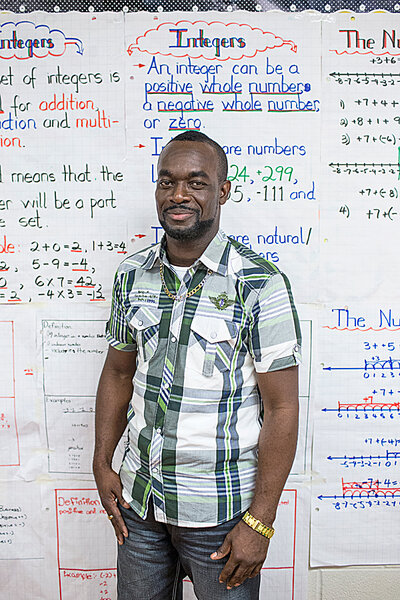Global education lessons: Canadian summer school transcends remedial
Loading...
| Toronto
Primed to perform, five middle school girls take their positions like dots on dice: four at each corner, the tallest in the center. In time to music, they carry invisible loads, push against air, wield imaginary shovels. Then the tall girl falls to the ground, while the others crouch around her. When the girl rises, arms raised in triumph, one of her classmates claps.
This work-in-progress explores the issue of child labor during drama/dance class at Dr. Marion Hilliard Senior Public School. This doesn't look like an English class, but the dancers' task is to select and impart information – through the same principles used when writing an essay – by relating a progression of ideas, and establishing a connection with the audience.
The class is part of a free, public summer program initiated this year by the Continuing Education Department (CED) of the Toronto District School Board.
Studies have shown that children from lower-income families disproportionately lose ground over the summer, putting them further behind as the school year resumes.
This is especially worrisome in the United States, where one-third of fourth-graders perform below basic reading levels and more than a quarter perform below basic level in math, according to the 2011 "Nation's Report Card," published by the US Department of Education. Summer learning loss is hardly something they can afford.
Even so, 90 percent of American summer school programs are remedial classes. This does nothing to help prevent students who barely passed into the next grade from running into problems down the line.
In Toronto, on the other hand, the CED required schools to develop summer curricula that addressed the needs of C and D students, but insisted the programs be open to all. The curricula are decidedly not remedial: They reflect a successful literacy and numeracy strategy that, since its establishment in 2004, has raised student scores, slowed teacher turnover, and reduced the percentage of very-low-performing schools from almost 20 percent to less than 5 percent.
Three teacher coaches visit schools throughout the one-month summer program, following students' progress. With this information, says CED head Karen Falconer, her team can then identify what works and what doesn't. This, in turn, feeds into province-wide efforts to build what educators refer to as the collective capacity of schools. For example, when a technique proves successful, teachers don't have to waste time reinventing the wheel and have gained more time for planning, peer consultations, and continuing education.
When Ms. Falconer's team launched the summer program, it began with a question: "What is it you think that your community needs?" Thirty schools responded with tailored programs, of which the CED accepted 24.
In the eastern suburb of Scarborough, the only summer option for many children is the street. Or, as seventh-grader Sughana Karunakaran says, "sitting on the couch all day." So the newly minted principal of Ellesmere-Statton Public School, Geri Yhap, structured a half day of basic literacy and numeracy classes with a dollop of physical education for incoming middle-schoolers.
"I forced my parents to force me to come," says Abdul Alrikabi, as he heads off to a session of tae kwon do. He adds with an impish smile: "I told them I'd forget half of what I learned in sixth grade."
At Greenholme Junior Middle School, principal Ali Abdi and his staff focused on their students' weakness in math – "specifically math word problems," he says. They also felt students would benefit from more time to digest the material and from building community through sports and special projects.
"Here, there needs to be a more deliberate focus on math," says teacher Cheddi Beckford. "In other schools, it can get integrated in other subjects."
This is the case at Hilliard, where "we wanted students to see they can use math in real life," says principal Rose Clarke. In one class, future ninth-graders are translating research on world hunger into charts and graphs.
Back in the drama/dance class, a critique is under way. Asked how she interpreted the dance, one student explains: "[The girl in the middle] was being pushed too hard. But then she got so strong she could stand up." Which pretty much sums up the governing philosophy of Ontario's education strategy and Toronto's summer schools.






